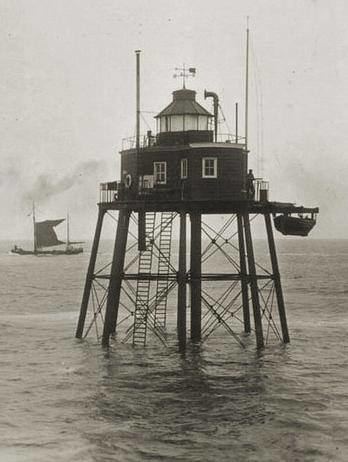Wannabe lighthouses - No.2 The Kish Bank light
Alexander Mitchell's pile light off the coast of Fleetwood in Lancashire. Constructed in 1840, it is probably similar in design to Mitchell's nearly-completed lighthouse on the Kish Bank in Dublin
This is the second installment of a three-part mini-series about Irish wannabe lighthouses which will be shown on Netflix starring Frances McDormand and that guy from Peaky Blinders.
Basically, a wannabe lighthouse is one where construction began but it never got to live the dream of sweeping its beam across the perilous sea.
Alexander Mitchell was a Dublin-born, Belfast-reared engineer who went blind at the age of 21. Undaunted, he carried on a brickmaking and building enterprise for 30 years until he retired to concentrate on his screw-pile method of construction, which he had patented. Basically, this consisted of screwing poles or piles into soft ground like a corkscrew and which, like a corkscrew, would not pull out straight. Thus he was able to construct lighthouses and piers at places hitherto impossible at a cost much cheaper than a standard lighthouse.
His first pile light is often quoted as being at Maplin Sands at the mouth of the Thames but, whereas this edifice was the first pile light to be started, like the hare, it decided to have a nap during construction and the tortoise-like Fleetwood Wyre light (above) pipped it to the post in 1840.
Alexander Mitchell c. 1855
Both lighthouses were big successes and Mitchell came to Dublin in triumph in the late Spring of 1842 at the behest of the Ballast Board to erect his infallible screwpile lighthouse on the Kish Bank at the entrance to Dublin Bay.
There had been a lightship on the Kish Bank since 1811. It occasionally broke its moorings in foul weather and required a large crew to maintain it. Mitchell's pile light would save the Ballast Board a lot of money, which could more usefully be spent on junkets.
And so work began apace. Mitchell was very much a hands-on manager - excuse the pun - personally overseeing (sorry again) every plank of wood or pole of iron for defects, often finding flaws that fully-sighted men had missed. He was also given to swimming down under the sea to check the positions of the piles and he occasionally fell in accidentally too. Like Mitchell, all was going swimmingly and the construction was springing up in a remarkably short space of time. It was found that the shifting, drifting sands were only a couple of feet thick, below which a rich blue clay was ideal for securing the piles. The piles were sunk and were just about ready to take the deck and housing when, in early November 1842, disaster struck, as described in the Freemans Journal of 19th November:
So what had gone wrong? Well, there were three main theories. One was that the piles had been hit by a vessel of some sort during the storm, as it would have needed great force to prise them out of the ground, anchored and braced as they were. Apparently none of the piles were left upright and all had disappeared beneath the waves.
Another said that, the piles, not being fully braced, were simply swept away by the storm. The third theory, and one that Halpin himself ascribed to, was that the piles had been sunk too close to the edge of the sandbank and that the storm had caused the whole bank to shift, forcing the piles out of the ground. Personally, I'm surprised that the notion of local Dublin gurriers out for a bit of craic never came up.
Sadly, there was no further attempt to resurrect this 'novelty in Pharoatic architecture.' Mitchell erected a steel buoy on the spot of the lighthouse and then went on his way to design and construct many more lighthouses and piers in Ireland, Britain and America. The lightship crew breathed a sigh of relief and continued guarding the bank until the 1960s, when a lighthouse was finally installed.
For years afterwards, Dublin Bay fishermen would complain about 'Mitchell's bloody piles' when coming ashore with nets ripped to shreds on submarine obstructions. More than one source of Irish shipwrecks has logged a wreck with the unusual name of 'Mitchell's Piles' as having gone down at the Kish in 1842!

An elderly Mr. Mitchell contemplates his 'bloody piles.'
The Kish lightship remained on the bank for 150 years before finally being superceded by the Kish lighthouse (below) in 1965









I think you have outdone yourself in puns, this time, Peter. But I love the idea of Mitchell swimming down to check everything. Why is this man not a household name and a national hero?
ReplyDeleteI have a theory, well-researched, that all Victorians were mad. As such, Mitchell wouldn't have stood out ...
DeleteI think the notion of a ship hitting it would have been very likely Pete, maybe even the Lightship ;) Would the sands have shifted so quickly overnight? I wouldn't have thought so.
ReplyDeleteYou may well be right, Andrew! Maybe the lightship hit it on purpose, safeguarding their jobs!!
ReplyDelete